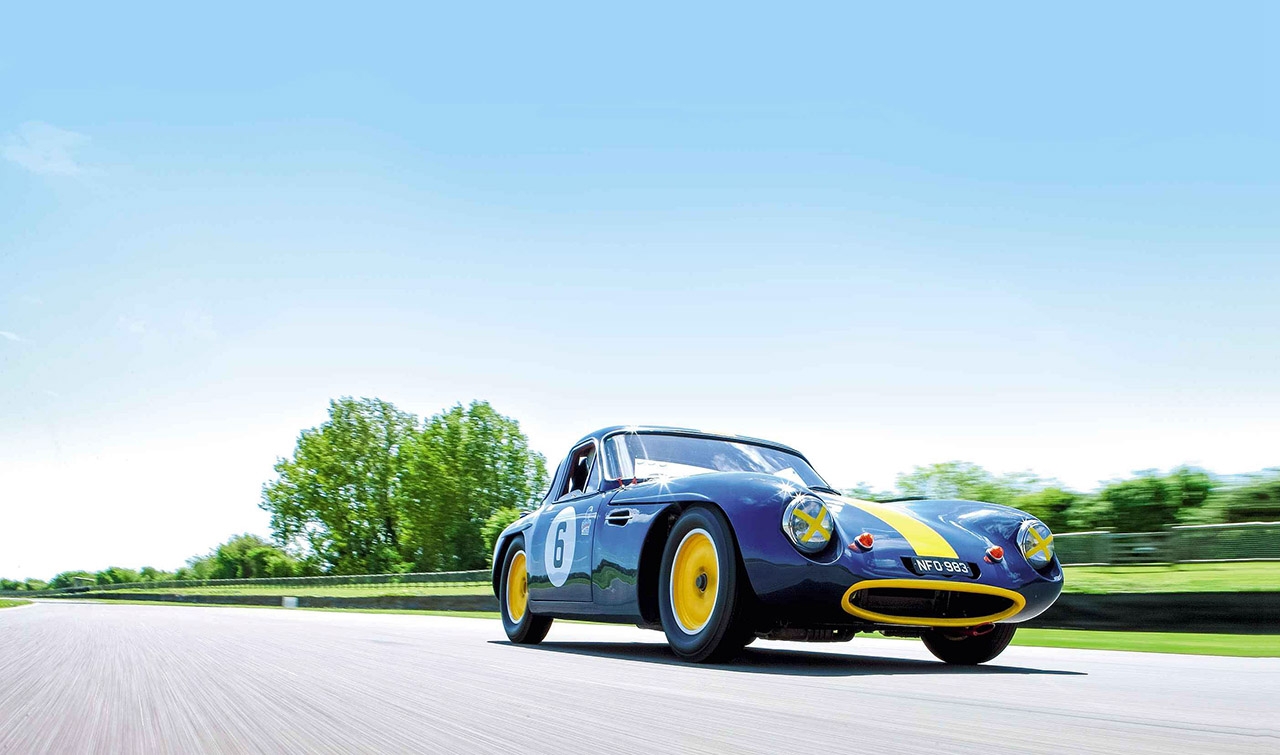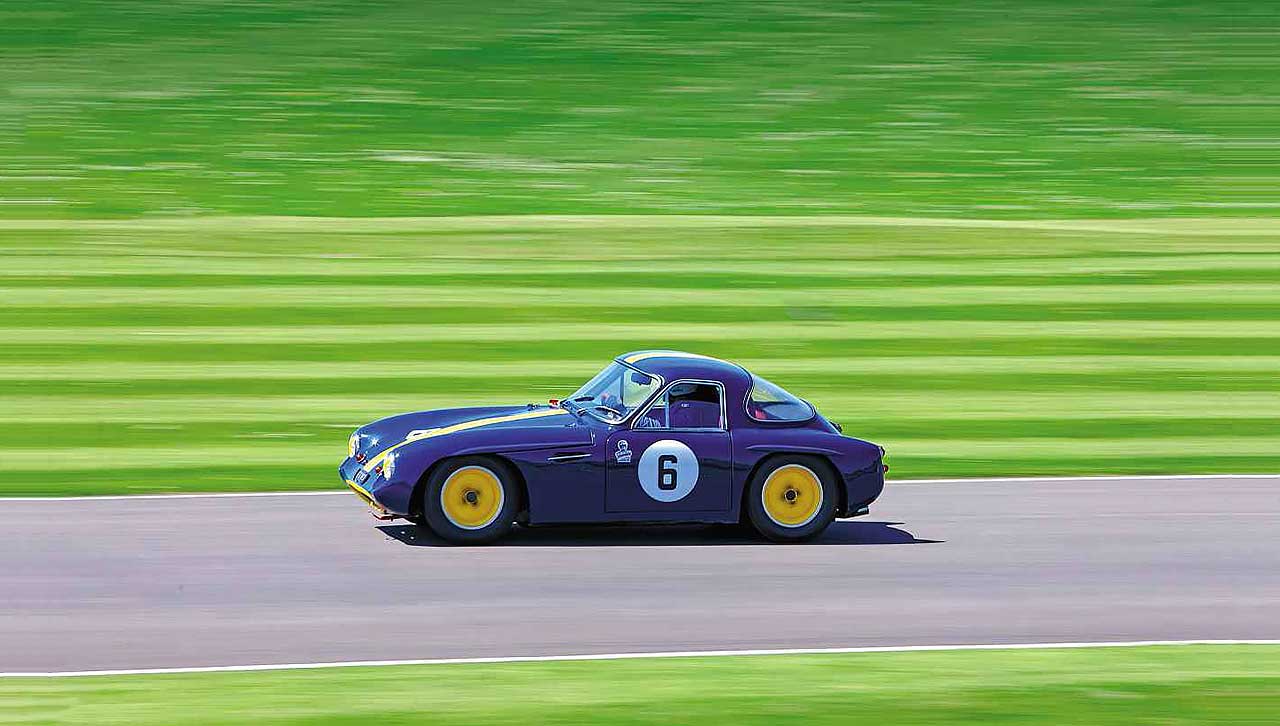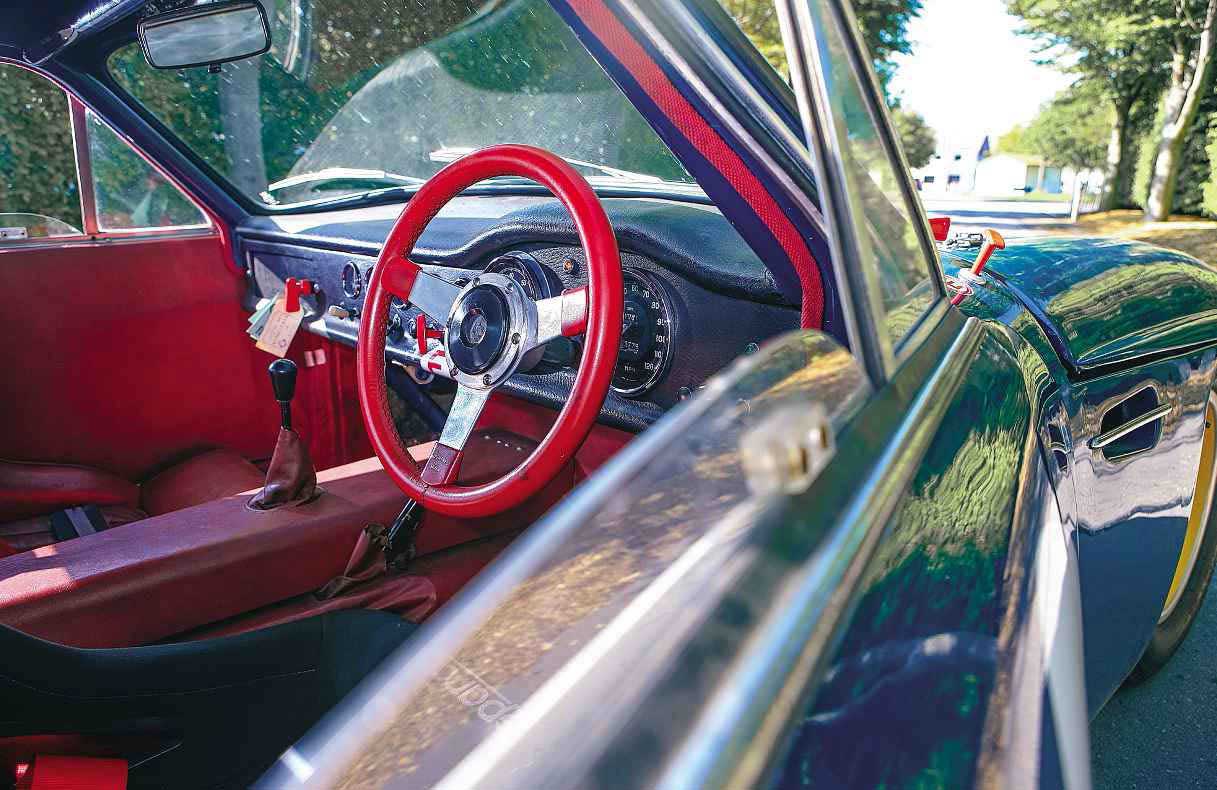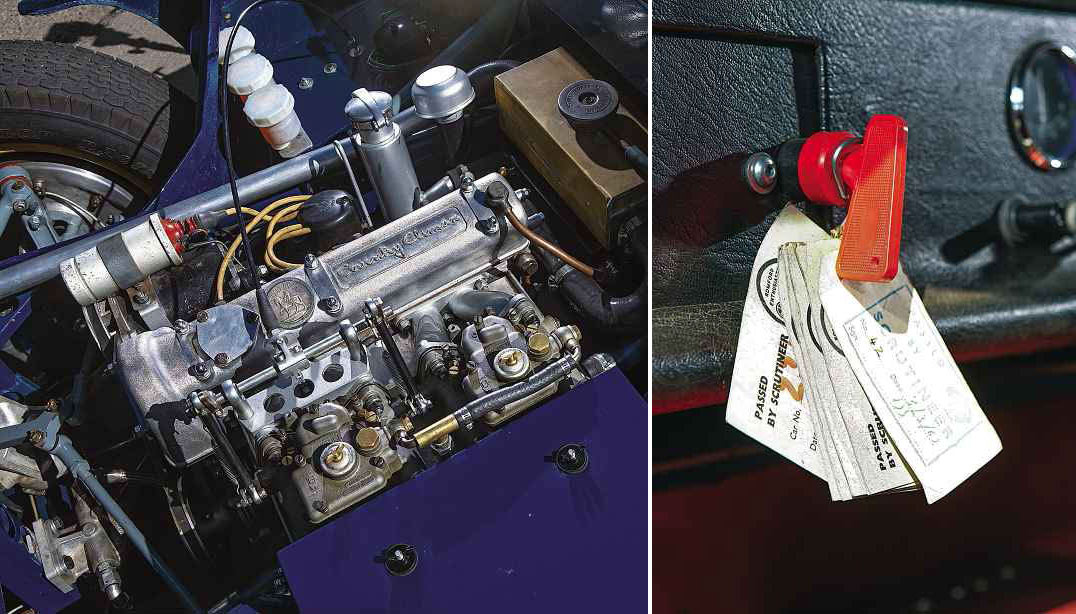
TVR Grantura MkII lightweight. On track in carefully restored works racer. Well worth the weight. This ultra-rare and valuable lightweight works TVR disappeared for four decades. Paul Chudecki charts its resurrection and recent racing success. Photography Lyndon McNeil.
These days it’s easy to forget the extent to which TVRs were raced back in the 1950s and 1960s. More often than not bought in kit form to avoid Purchase Tax, the affordable, nimble and light sports car from Blackpool was a prolific and frequent entrant in club racing, sprints and hillclimbs. By 1960, TVR’s enthusiastic customers had firmly established the marque as a force in competition, usually driving Coventry-Climax-powered Granturas, with some even benefiting from works backing.

Above and right TVR was repainted using correctly matched colours – the original livery was present but faded; patinated red interior trim is original.
The perpetually troubled minnow manufacturer was also enjoying a short-term stable financial period, enough to introduce an updated version of its sole model. It hoped that the introduction of the Grantura MkII in the middle of the year would help stem the ebbing financial tide at the Blackpool works, and it certainly played its part.
Mechanically the MkII was identical to its predecessor – multi-tubular backbone chassis with all-independent, VW Beetle-derived trailing arms and transverse torsion bars front and rear, plus Austin-Healey 100 drums all-round – but with a lighter, higher-quality glassfibre body. There was even a minor facelift, with reshaped rear wings and small fins supporting new tail lamps, together with wheelarch ribflares to match those at the front, plus new front indicators.
Engine options also changed. The most common fitment was the MGA’s 79.5bhp 1588cc unit (as opposed to the previous 72bhp 1489cc motor). Again the 39bhp 997cc Ford and 83bhp 1216cc Coventry-Climax FWE engines were available, but the woefully underpowered 1172cc sidevalve Ford was discontinued.

The facelift softened the Grantura’s stubby appearance, allowing a more rakish side profile, and the car was wellreceived. Although MkII production only lasted eight months, around 400 examples were bought fully built or in kit form, and in early 1961 it was further improved as the MkIIA with standard Girling front disc brakes and increased engine options, to become TVR’s most successful model thus far.
Before the latter’s introduction, however, TVR had built four special works lightweight MkII development cars specifically for competition use with a strengthened but lighter drilled chassis, thin-gauge glassfibre body, lightweight magnesium ‘wobbly web’ wheels, and the Coventry-Climax FWE engine mated to an MGA (or optional ZF) close-ratio gearbox.
Believed to be the first of these (it’s possible that two others survive), chassis 7/C/238 was registered in October 1960 and ran in British National/International events, latterly with a ’Climax 1460cc FWB engine. It was sponsored by TVR shareholder Arnold Burton (a director of his father’s tailoring business, and later founder of Harewood Hillclimb) for the remainder of that year’s season and the first half of 1961’s, bore the distinctive ‘AUD 100’ registration, and wore blue paintwork and yellow central stripe and radiator intake noseband.
The TVR was driven mainly by John Woolfe, founder of John Woolfe Racing in 1967, who married Burton’s niece, and whose opening-lap crash in a Porsche 917 at Le Mans in 1969 caused his death and the abandonment of the traditional drivers’ sprint at the start of the 24 Hours. His notable 1961 race entries with 7/C/238 (he also raced another Lightweight, 7/C/345, but with an MGA engine) included the GT race at Snetterton’s Lombank Trophy International meeting and the Fordwater Trophy at Goodwood’s Easter Monday meeting. The car was also entered for the 1962 Nürburgring 1000km by TVR with Ninian Sanderson as co-driver, but it failed to make the start.

After a 1961 Autosport advertisement described the TVR as ‘built regardless of expense’, it was bought by Michael Sargeant without its Coventry-Climax engine (the C in the chassis number denotes a Climax-engined car). An MGA unit with crossflow HRG-Derrington cylinder head and twin Weber 40DCOE carburettors was installed before Sargeant raced the TVR regularly in British National events from 1962 to 1964, including the BRSCC British Sports Car Championship. In October 1964, chassis 7/C/238 passed to Bill Cook, who continued to campaign the car in club races, mainly at Snetterton and Brands Hatch, until 1971.
With only 3150 miles on the odometer the Grantura went into dry storage, where it remained for 40 years, bar some brief road use in the late 1990s. It was acquired by Bugatti specialist Ivan Dutton in 2013 – and was still exactly as it finished its last race, right down to its original, faded Oxford Blue paintwork (the yellow stripe and radiator intake surround were just discernible), red leather interior, and scrutineering tags hanging from the ignition cut-out. Dutton had already bought an Elva Courier and, when seller Jim Lowry revealed the long-dormant TVR, he knew at once that he had to have it.
‘Being involved in Bugattis, originality means so much to everybody,’ explains Dutton. ‘Seeing a car that hadn’t been used for donkey’s years, all original, I just had to buy it. I never thought I’d buy a TVR. I always thought they were funny little cars, to be honest.’
A sympathetic restoration followed, prior to which sandblasting revealed not one trace of chassis rust. ‘We couldn’t find anything wrong with it, it was just beautiful,’ says Dutton. ‘That’s when I realised that the amount I’d paid for it was warranted.’
Rubbing down the bodywork revealed that the Grantura still had only its original Oxford Blue paint. ‘We didn’t have to rub a lot of paint off because it hadn’t been repainted,’ says Dutton. ‘You could still see the line where the yellow stripe had been put on. All the trim was mint, we had the rollcage made and I had some patterns made for the wheels.’
The TVR was repainted using correctly matched colours, the interior reinstalled, and the original, refurbished mechanical components reattached, bar the MGA crossflow motor, which was replaced with a Coventry-Climax engine. ‘We put the ’Climax back in exactly where it obviously went originally, we just made mountings for it, and then we had to make a plate to go between engine and gearbox, which has been done a million times so wasn’t difficult.’
Dutton estimates that the engine – with a brace of Weber 40DCOEs and breathing through inlet and exhaust manifolds beautifully fabricated in-house by right-hand man John Berry, as was the carb’s cold-air box – should produce about 130bhp. Dutton fabricated the alloy oil catch tank for the engine and the radiator’s brass header tank, as well as making the period-style throttle linkage from scratch, while the original pedal-box was retained but converted to twin cylinders in case of failure.
‘Oh, and the front back-plates were made of magnesium and they’d just corroded away,’ says Dutton, ‘so we built them up, turned them into a pattern and had them cast in aluminium. And the brake drums were absolutely beautiful – obviously with 3000 miles – just lovely condition.
Everything we did we tried to do as nicely as we could.’ Total weight with all fluids, incidentally, is just 1413lb (641kg) and Dutton jokes that the Coventry-Climax engine weighs about the same as the HRG cylinder head off the MGA unit. ‘I’m very, very pleased with it,’ he says of the car. ‘Really, it’s a nice thing to have.’
The Grantura Lightweight was readied in time for its return (complete with MoT certificate) to the track at Goodwood’s 73rd Members’ Meeting, finished to a high standard though with the suspension far from ideally set-up. Dutton finished 17th in the Les Leston Cup, following it with a class win at the Chateau Impney hillclimb.

Above from left. 1216cc Coventry-Climax four-cylinder is of the type the car ran originally; scrutineering tags date back to its 1960s racing career.
Now, back at Goodwood on a glorious sunny day, it’s time to sample the TVR. You sit close to the red leather-rim wheel, arms very much akimbo. The interior is as beautifully finished as the rest of the car, its trim exuding genuine period patina, while the Sparco high-back racing seat (not required under period race regulations) is a sensible safety precaution, likewise the full rollcage with driver’s side-intrusion bar.
Ahead, the simple dash houses large Smiths 120mph speedometer and similar-size 8000rpm revcounter directly in front of the driver, with auxiliary instruments and sundry switches running across. A relatively light throttle and gradual easing out of the clutch is all that is needed to pull away cleanly and, once rolling, the MkII Lightweight accelerates eagerly onto the Sussex track.
Use around 6000rpm, change gears swiftly in the closeratio four-speed, straight-cut MGA ’box, and acceleration is strong, although you have to ready your left foot over the high-mounted clutch pedal close to the transmission tunnel, and there’s a slight tailing-off of power at high engine speeds.
Turn-in is quick via the worm-and-peg steering and, while the rear is a little loose with power on through fast corners such as Madgwick and Fordwater (taken not quite flat-out but requiring a slight oversteer correction), the short-wheel-base Grantura proves less twitchy than I expected.
Once the 500L-section Dunlop tyres (rims are 5in by 15in) are up to temperature, the faster you drive, the better it feels. The impression overall is of a well-balanced chassis, and the 11.6in diameter brakes, with drums drilled to help cooling (Alfins were a factory option), are surprisingly effective once some heat has got into them.
Dutton then invites me to share his MkII Lightweight in a two-hour race at the Algarve Classic Festival. Entered in the Automobiles Historiques-organised GT & Sports Car Cup, and having taken Brittany Ferries’ comfortably equipped, day-long Portsmouth-Santander crossing before trailering the TVR 650 miles to Portimao on the southernmost tip of Portugal, we arrive at the fabulous F1-homologated circuit for qualifying – only to be met by persistent heavy rain.
The TVR has never been run in the wet, let alone set up for it. Dutton hands over to me with the encouraging words: ‘It’s lethal!’ With its steep climbs and drops, blind brows, cambers, rapid corners, hairpins and undulating nature, the 2.9-mile track is reminiscent of Spa, but in the wet the stubby TVR wants to throw itself off at the slightest hint of throttle and, on this difficult-to-learn circuit, after a handful of such laps (made yet more dangerous after a car deposits oil over the entire track), I’m still trying to figure out which way it goes. What I do manage to learn is that, now I’m able to use the upper reaches of the revcounter (up to 7000rpm – a bad connection in the distributor had been curtailing efforts at Goodwood), the ’Climax revs eagerly and strongly with no let-up, as long as the revs are kept above 2750rpm. It feels notably crisper, almost transformed compared with testing at Goodwood.

The uncharacteristically inclement weather persists for the start early the following day and then stops, but as I head off in the Grantura for my stint (Dutton’s comment this time is simply ‘No good!’) it soon becomes clear that the track will never dry and will remain extremely slippery throughout. With tyre pressures down a couple of pounds there is a minor improvement in grip and, gradually, helped by watching the squirrelling, frequently well-out-of-shape Cobras, Morgan SLRs, E-types and Big Healeys, my knowledge of the circuit increases.
Despite me constantly fighting oversteer left and right (and getting extremely crossed-up, if never quite to the point of no return) and judicious throttle balancing, the stumpy TVR still proves nimble, with punchy acceleration out of the slower turns – although there’s no limited-slip in the 4.5:1 diff – once power can be properly applied. For half-a-dozen laps it holds off a much quicker 911, even down the long pit straight (where heavy braking would produce a slight shudder but never any sign of fade from the drums), until the Porsche gets the better break in traffic, and is long gone. In the dry, of course, there would be no contest.
But then, with some 16 minutes remaining, the right-front Dunlop picks up a slow puncture and I slowly limp back to the pits, our race over, a disappointed Dutton then telling me we’d been leading our class from an Austin-Healey 100, if only because its drivers chose to do half-hourly stints! So it’s a welcome surprise to learn later that we have been classified as a finisher. Second in class, no less.
Demanding and relentless best describes the superb Portimao circuit, particularly in such treacherous conditions, yet, apart from that puncture (caused by nothing more threatening than a half-inch self-tapping screw!), the diminutive and entertaining TVR never missed a beat during 1½ hours of strenuous use. It has proved its ability to punch well above its weight in difficult circumstances; testament, perhaps, not only to its design but also to Ivan Dutton’s high standards of preparation and meticulous attention to detail.
THANKS TO Goodwood Circuit, www.goodwood.com; Brittany Ferries, www.brittany-ferries.co.uk; Ivan Dutton Ltd, www.duttonbugatti.co.uk.
1960 TVR Grantura MkII Lightweight
Engine 1216cc four-cylinder, OHC, twin Weber 40DCOE carburettors
Power 130bhp @ 6500rpm (est)
Transmission Four-speed manual, rear-wheel drive
Steering Worm and peg
Suspension Front: trailing arms, transverse torsion bars, telescopic dampers, anti-roll bar. Rear: trailing arms, torsion bars, telescopic dampers
Brakes Drums, drilled for cooling
Weight 641kg
Performance Top speed 140mph (est)
‘Once the Dunlop tyres are up to temperature, the faster you drive, the better it feels’
‘With only 3150 miles on the odometer the Grantura went into dry storage, where it remained for 40 years’





